Michael Klare says naval robotic warfare is beginning to move out of dystopian futuristic fantasies and into official battlefield visions.
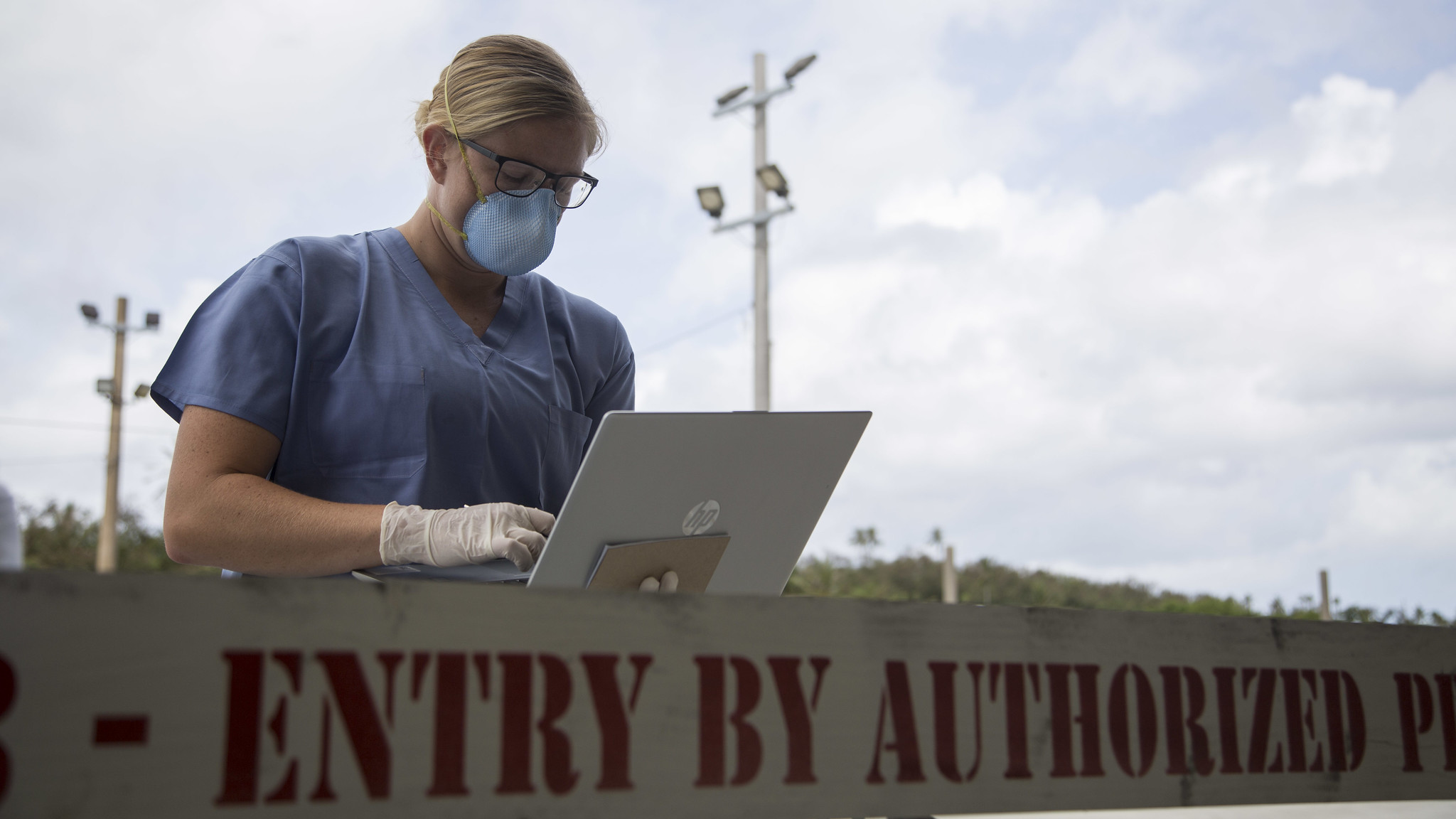
U.S. Navy lieutenant records vitals during morning medical checks for sailors assigned to aircraft carrier USS Theodore Roosevelt, May 1, 2020, at Naval Base Guam. (U.S. Marine Corps, Jordan E. Gilbert)
By Michael T. Klare
TomDispatch.com
 On March 26, the Coronavirus accomplished what no foreign adversary has been able to do since the end of World War II: it forced an American aircraft carrier, the USS Theodore Roosevelt, to suspend patrol operations and shelter in port. By the time that ship reached dock in Guam, hundreds of sailors had been infected with the disease and nearly the entire crew had to be evacuated.
On March 26, the Coronavirus accomplished what no foreign adversary has been able to do since the end of World War II: it forced an American aircraft carrier, the USS Theodore Roosevelt, to suspend patrol operations and shelter in port. By the time that ship reached dock in Guam, hundreds of sailors had been infected with the disease and nearly the entire crew had to be evacuated.
As news of the crisis aboard the TR (as the vessel is known) became public, word came out that at least 40 other U.S. warships, including the carrier USS Ronald Reagan and the guided-missile destroyer USS Kidd, were suffering from Covid-19 outbreaks. None of these approached the scale of the TR and, by June, the Navy was again able to deploy most of those ships on delayed schedules and/or with reduced crews.
By then, however, it had become abundantly clear that the long-established U.S. strategy of relying on large, heavily armed warships to project power and defeat foreign adversaries was no longer fully sustainable in a pandemic-stricken world.
Just as the Navy was learning that its preference for big ships with large crews — typically packed into small spaces for extended periods of time — was quite literally proving a dead-end strategy (one of the infected sailors on the TR died of complications from Covid-19), the Army and Marine Corps were making a comparable discovery. Their favored strategy of partnering with local forces in far-flung parts of the world like Iraq, Japan, Kuwait, and South Korea, where local safeguards against infectious disease couldn’t always be relied on (or, as in Okinawa recently, Washington’s allies couldn’t count on the virus-free status of American forces), was similarly flawed.
With U.S. and allied troops increasingly forced to remain in isolation from each other, it is proving difficult to conduct the usual joint training-and-combat exercises and operations.
In the short term, American defense officials have responded to such setbacks with various stopgap measures, including sending nuclear-capable B-1, B-2, and B-52 bombers on long-range “show-of-force” missions over contested areas like the Baltic Sea (think: Russia) or the South China Sea (think: China, of course). “We have the capability and capacity to provide long-range fires anywhere, anytime, and can bring overwhelming firepower — even during the pandemic,” insisted General Timothy Ray, commander of the Air Force Global Strike Command, after several such operations.
In another sign of tactical desperation, however, the Navy ordered the shattered crew of the TR out of lockdown in May so that the ship could participate in long-scheduled, China-threatening multi-carrier exercises in the western Pacific. A third of its crew, however, had to be left in hospitals or in quarantine on Guam.
“We’re executing according to plan to return to sea and fighting through the virus is part of that,” said the ship’s new captain, Carlos Sardiello, as the TR prepared to depart that Pacific island. (He had been named captain on April 3 after a letter the carrier’s previous skipper, Brett Crozier, wrote to superiors complaining of deteriorating shipboard health conditions was leaked to the media and the senior Navy leadership fired him.)
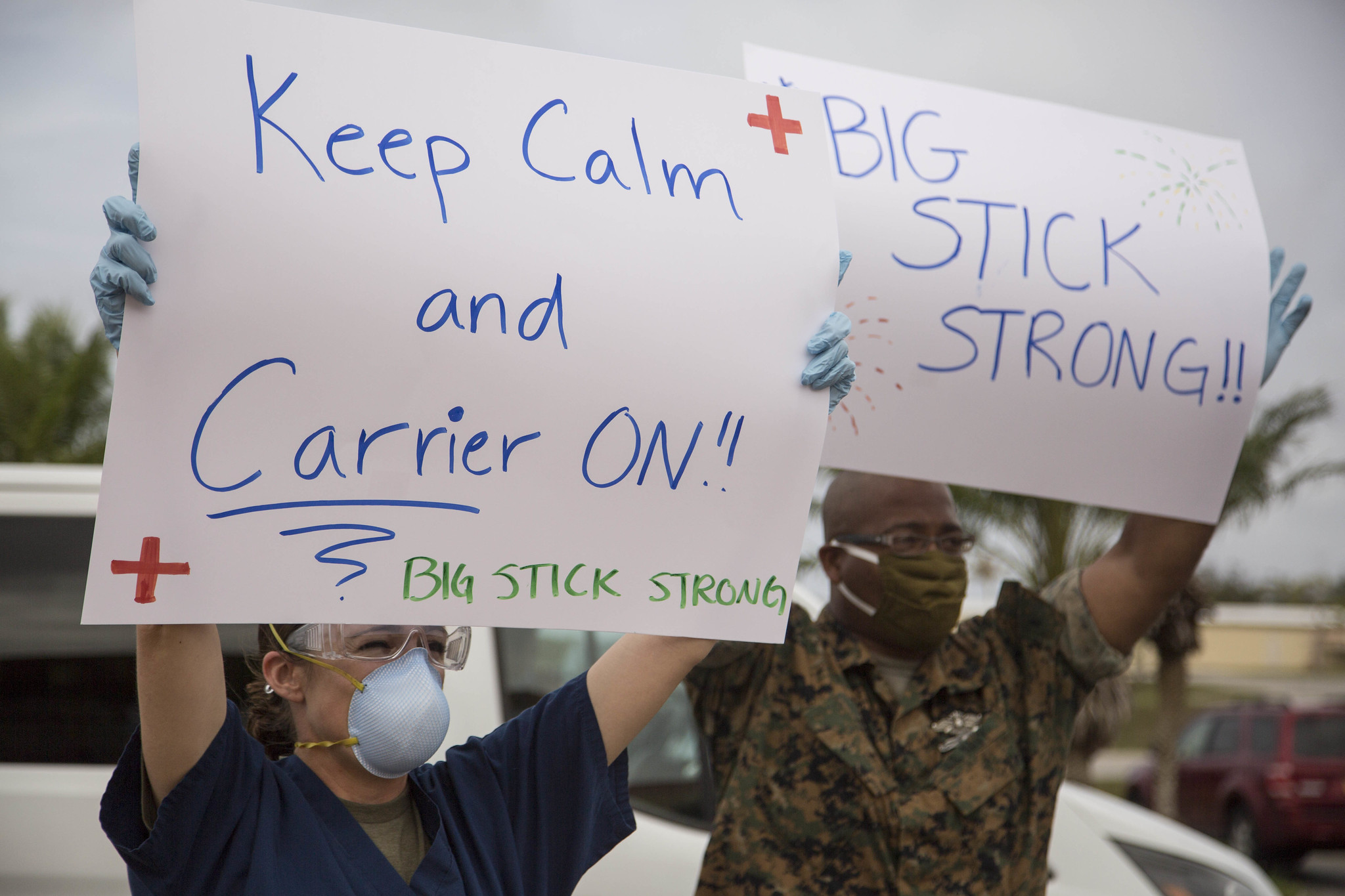
Medical battalion sailors show support for crew members of USS Theodore Roosevelt Sailors departing isolation at Guam Naval base on May 2, 2020. (U.S. Marine Corps, Jordan E. Gilbert)
Such stopgap measures, and others like them now being undertaken by the Department of Defense, continue to provide the military with a sense of ongoing readiness, even aggressiveness, in a time of Covid-related restrictions. Were the current pandemic to fade away in the not-too-distant future and life return to what once passed for normal, they might prove adequate.
Scientists are warning, however, that the coronavirus is likely to persist for a long time and that a vaccine — even if successfully developed — may not prove effective forever. Moreover, many virologists believe that further pandemics, potentially even more lethal than Covid-19, could be lurking on the horizon, meaning that there might never be a return to a pre-pandemic “normal.”
That being the case, Pentagon officials have been forced to acknowledge that the military foundations of Washington’s global strategy — particularly, the forward deployment of combat forces in close cooperation with allied forces — may have become invalid. In recognition of this harsh new reality, U.S. strategists are beginning to devise an entirely new blueprint for future war, American-style: one that would end, or at least greatly reduce, a dependence on hundreds of overseas garrisons and large manned warships, relying instead on killer robots, a myriad of unmanned vessels, and offshore bases.
Ships Without Sailors
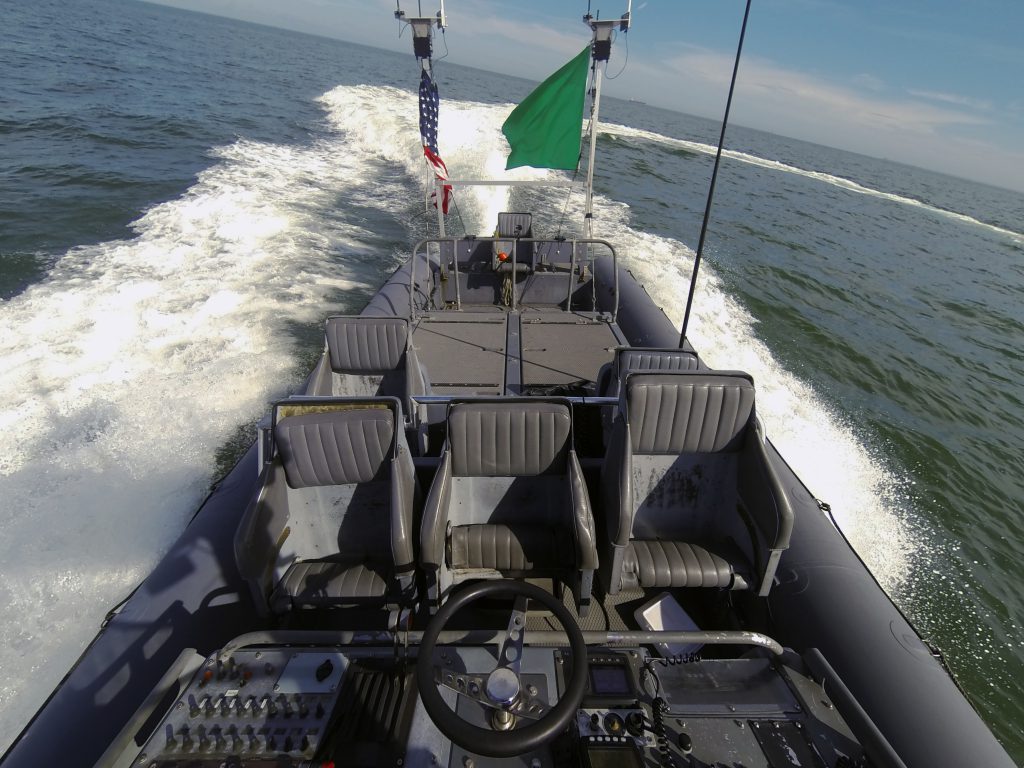
Unmanned 11-meter rigid hulled inflatable boat (RHIB) operates autonomously during a demonstration on the James River in Newport News, Virginia, Aug. 12, 2014. (U.S. Navy, John F. Williams)
In fact, the Navy’s plans to replace large manned vessels with small, unmanned ones was only accelerated by the outbreak of the pandemic. Several factors had already contributed to the trend: modern warships like nuclear-powered aircraft carriers and missile-armed cruisers had been growing ever more expensive to build.
The latest, the USS Gerald R. Ford, has cost a whopping $13.2 billion and still doesn’t work to specifications. So even a profligately funded Pentagon can only afford to be constructing a few at a time. They are also proving increasingly vulnerable to the sorts of anti-ship missiles and torpedoes being developed by powers like China, while, as events on the TR suggest, they’re natural breeding grounds for infectious diseases.
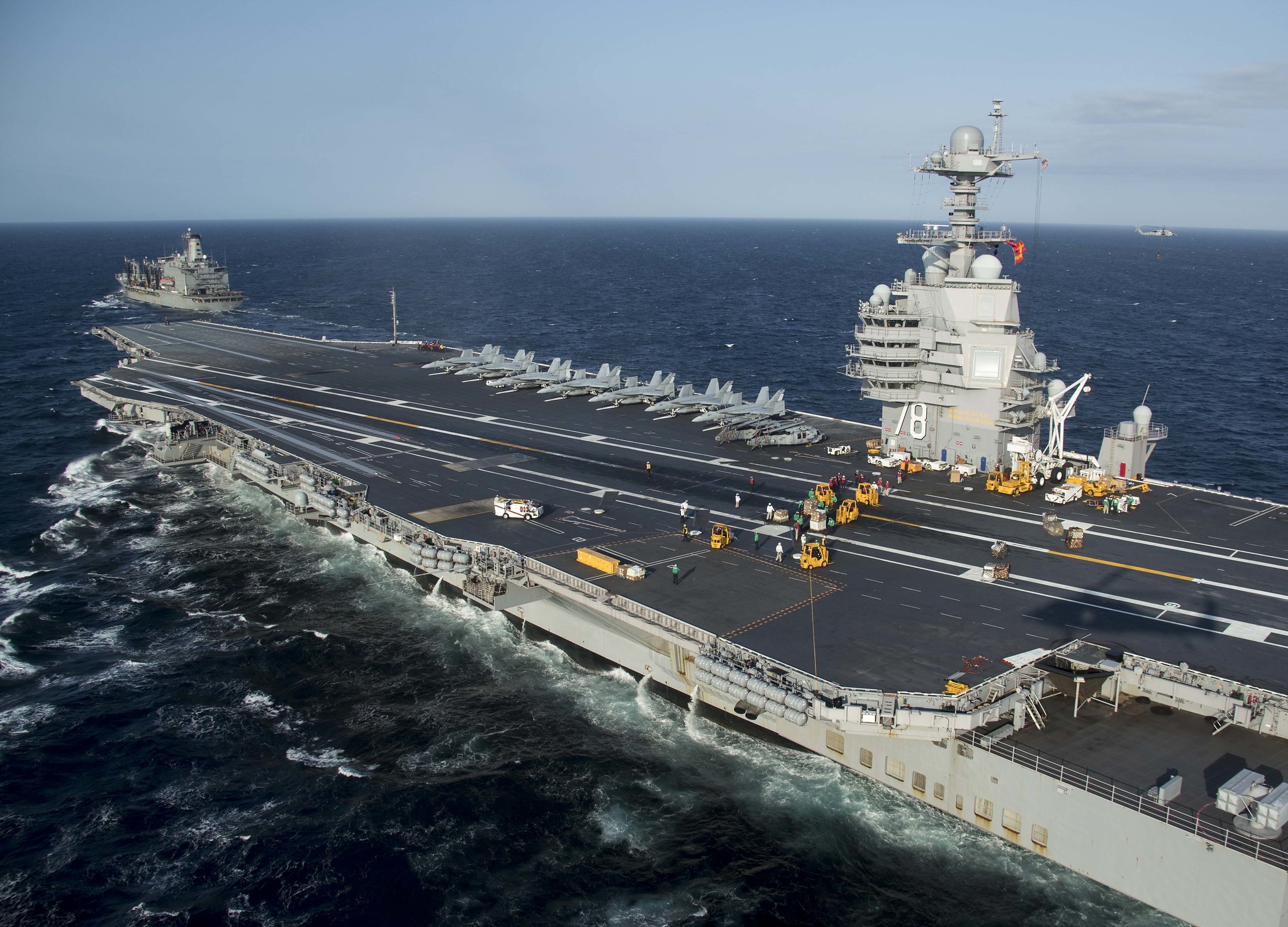
The USS Gerald R. Ford aircraft carrier pulls alongside a replenishment oiler in the Atlantic Ocean, May 15, 2020. (U.S. Navy, Ruben Reed)
Until the disaster aboard the Theodore Roosevelt, most worrisome were those Chinese land-based, anti-ship weapons capable of striking American carriers and cruisers in distant parts of the Pacific Ocean. This development had already forced naval planners to consider the possibility of keeping their most prized assets far from China’s shores in any potential shooting war, lest they be instantly lost to enemy fire.
Rather than accept such a version of defeat before a battle even began, Navy officials had begun adopting a new strategy, sometimes called “distributed maritime operations,” in which smaller manned warships would, in the future, be accompanied into battle by large numbers of tiny, unmanned, missile-armed vessels, or maritime “killer robots.”
In a reflection of the Navy’s new thinking, the service’s surface warfare director, Rear Admiral Ronald Boxall, explained in 2019 that the future fleet, as designed, was to include “104 large surface combatants [and] 52 small surface combatants,” adding, “That’s a little upside down. Should I push out here and have more small platforms? I think the future fleet architecture study has intimated ‘yes,’ and our war gaming shows there is value in that… And when I look at the force, I think: Where can we use unmanned so that I can push it to a smaller platform?”

Rear Adm. Ronald Boxall at right on June 5, 2018, during commemoration of the 76th anniversary of the Battle of Midway. (U.S. Navy, Stephen Hassay)
Think of this as an early public sign of the rise of naval robotic warfare, which is finally leaving dystopian futuristic fantasies for actual future battlefields. In the Navy’s version of this altered landscape, large numbers of unmanned vessels (both surface ships and submarines) will roam the world’s oceans, reporting periodically via electronic means to human operators ashore or on designated command ships. They may, however, operate for long periods on their own or in robotic “wolf packs.”
Such a vision has now been embraced by the senior Pentagon leadership, which sees the rapid procurement and deployment of such robotic vessels as the surest way of achieving the Navy’s (and President Donald Trump’s) goal of a fleet of 355 ships at a time of potentially static defense budgets, recurring pandemics, and mounting foreign threats.
“I think one of the ways you get [to the 355-ship level] quickly is moving toward lightly manned [vessels], which over time can be unmanned,” Secretary of Defense Mark Esper typically said in February. “We can go with lightly manned ships… You can build them so they’re optionally manned and then, depending on the scenario or the technology, at some point in time they can go unmanned… That would allow us to get our numbers up quickly, and I believe that we can get to 355, if not higher, by 2030.”
To begin to implement such an audacious plan, that very month the Pentagon requested $938 million for the next two fiscal years to procure three prototype large unmanned surface vessels (LUSVs) and another $56 million for the initial development of a medium-sized unmanned surface vessel (MUSV). If such efforts prove successful, the Navy wants another $2.1 billion from 2023 through 2025 to procure seven deployable LUSVs and one prototype MUSV.
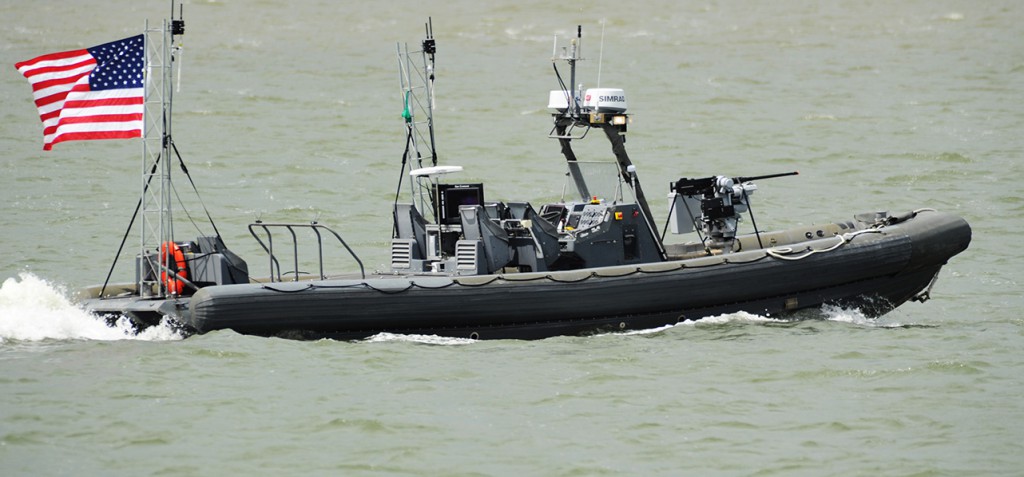
Full view of the unmanned rigid-hulled inflatable boat (RHIB) during a demonstration in Newport News, Virginia, Aug. 12, 2014. (U.S. Navy, John F. Williams)
Naval officials have, however, revealed little about the design or ultimate functioning of such robot warships. All that service’s 2021 budget request says is that “the unmanned surface vessel (USV) is a reconfigurable, multi-mission vessel designed to provide low cost, high endurance, reconfigurable ships able to accommodate various payloads for unmanned missions and augment the Navy’s manned surface force.”
Based on isolated reports in the military trade press, the most that can be known about such future (and futuristic) ships, is that they will resemble miniature destroyers, perhaps 200 feet long, with no crew quarters but a large array of guided missiles and anti-submarine weapons. Such vessels will also be equipped with sophisticated computer systems enabling them to operate autonomously for long periods of time and — under circumstances yet to be clarified — take offensive action on their own or in coordination with other unmanned vessels.
The future deployment of robot warships on the high seas raises troubling questions. To what degree, for instance, will they be able to choose targets on their own for attack and annihilation?
The Navy has yet to provide an adequate answer to this question, provoking disquiet among arms control and human rights advocates who fear that such ships could “go rogue” and start or escalate a conflict on their own. And that’s obviously a potential problem in a world of recurring pandemics where killer robots could prove the only types of ships the Navy dares deploy in large numbers.
Fighting from Afar
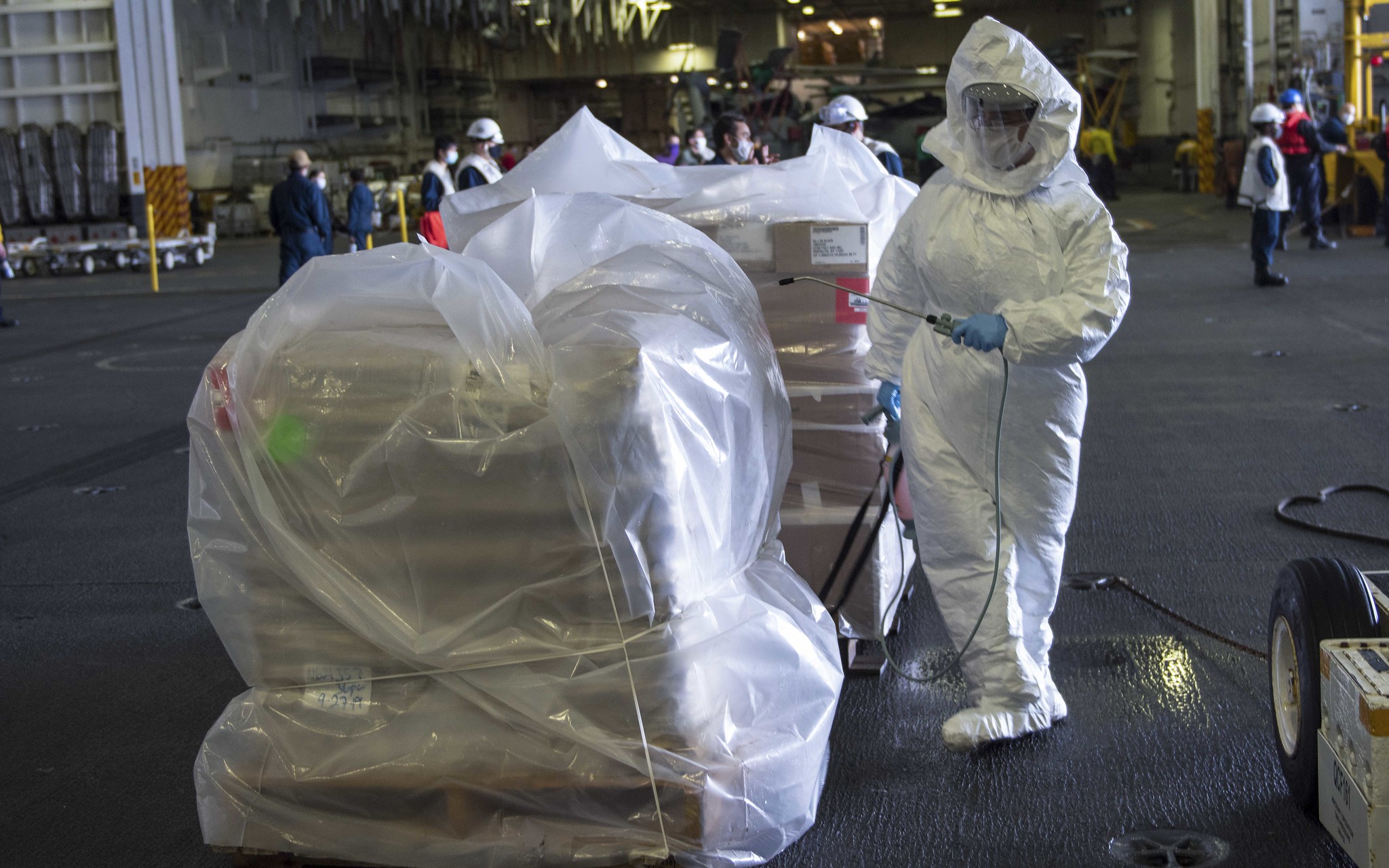
Navy specialist on forward-deployed USS Ronald Reagan disinfects oncoming cargo during a replenishment in the Philippine Sea, May 22, 2020. (U.S. Navy, David C. Warren)
When it comes to the prospect of recurring pandemics, the ground combat forces of the Army and Marine Corps face a comparable dilemma.
Ever since the end of World War II, American military strategy has called for U.S. forces to “fight forward” — that is, on or near enemy territory rather than anywhere near the United States. This, in turn, has meant maintaining military alliances with numerous countries around the world so that American forces can be based on their soil, resulting in hundreds of U.S. military bases globally.
In wartime, moreover, U.S. strategy assumes that many of these countries will provide troops for joint operations against a common enemy. To fight the Soviets in Europe, the U.S. created NATO and acquired garrisons throughout Western Europe; to fight communism in Asia, it established military ties with Japan, South Korea, South Vietnam, the Philippines, and other local powers, acquiring scores of bases there as well.
When Afghanistan, Iran, Iraq, and Islamic terrorism became major targets of its military operations, the Pentagon forged ties with and acquired bases in Afghanistan, Bahrain, Djibouti, Iraq, Kuwait, Oman, Saudi Arabia, and the United Arab Emirates, among other places.
In a pandemic-free world, such a strategy offers numerous advantages for an imperial power. In time of war, for example, there’s no need to transport American troops (with all their heavy equipment) into the combat zone from bases thousands of miles away. However, in a world of recurring pandemics, such a vision is fast becoming a potentially unsustainable nightmare.
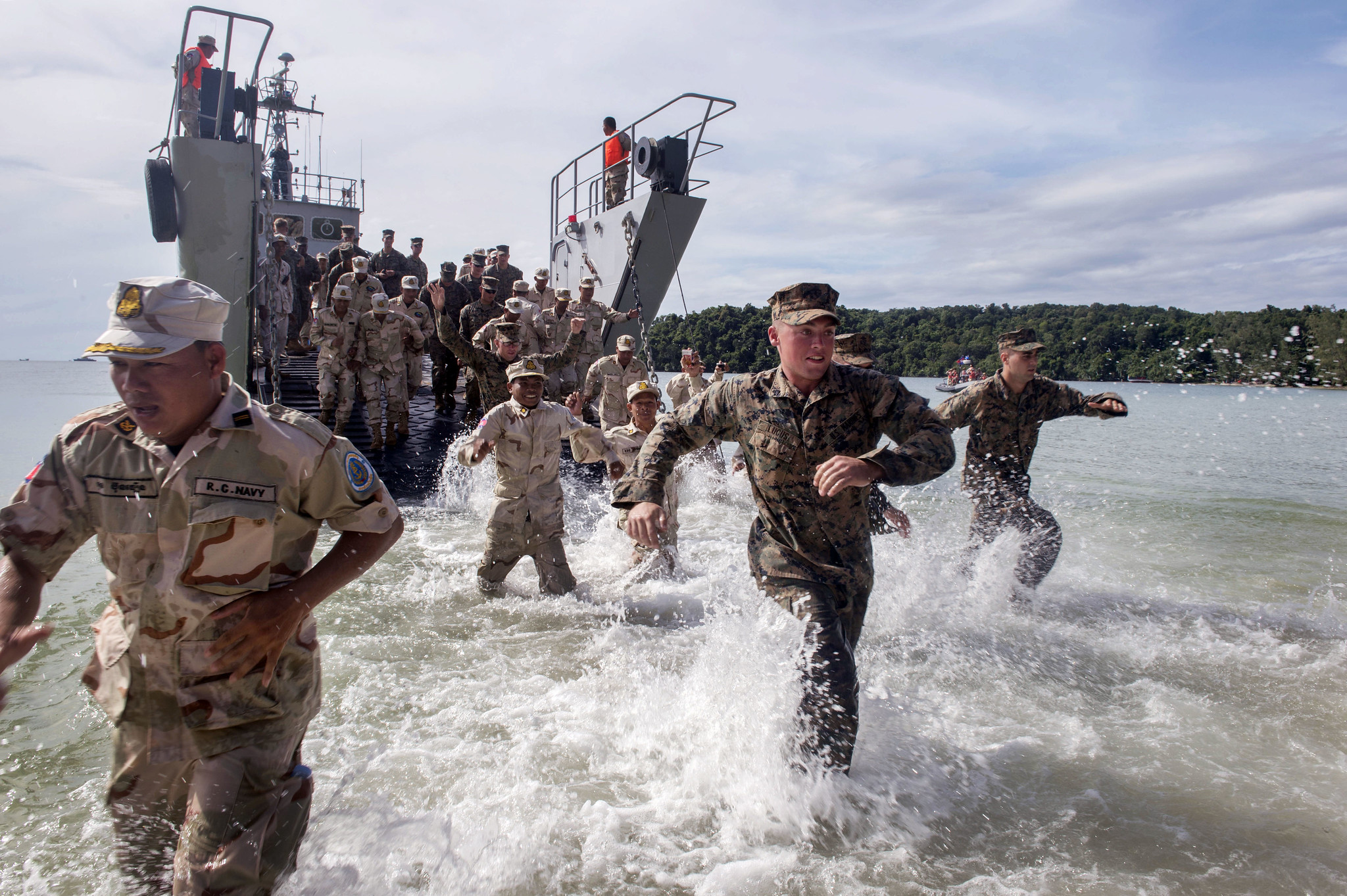
In 2016, U.S. Marines and members of the partner Royal Cambodian Navy disembark an RCN amphibious landing craft during a field training exercise in Sihanoukville, Cambodia. (U.S. Navy, Lowell Whitman)
To begin with, it’s almost impossible to isolate thousands of U.S. soldiers and their families (who often accompany them on long-term deployments) from surrounding populations (or those populations from them). As a result, any viral outbreak outside base gates is likely to find its way inside and any outbreak on the base is likely to head in the opposite direction.
This, in fact, occurred at numerous overseas facilities this spring. Camp Humphreys in South Korea, for example, was locked down after four military dependents, four American contractors, and four South Korean employees became infected with Covid-19. It was the same on several bases in Japan and on the island of Okinawa when Japanese employees tested positive for the virus (and, more recently, when U.S. military personnel at five bases there were found to have Covid-19).
Add in Camp Lemonnier in Djibouti and Ahmed al-Jaber Air Base in Kuwait, not to speak of the fact that, in Europe, some 2,600American soldiers have been placed in quarantine after suspected exposure to Covid-19. (And if the U.S. military is anxious about all this in other countries, think about how America’s allies feel at a moment when Donald Trump’s America has become the epicenter of the global coronavirus pandemic.)
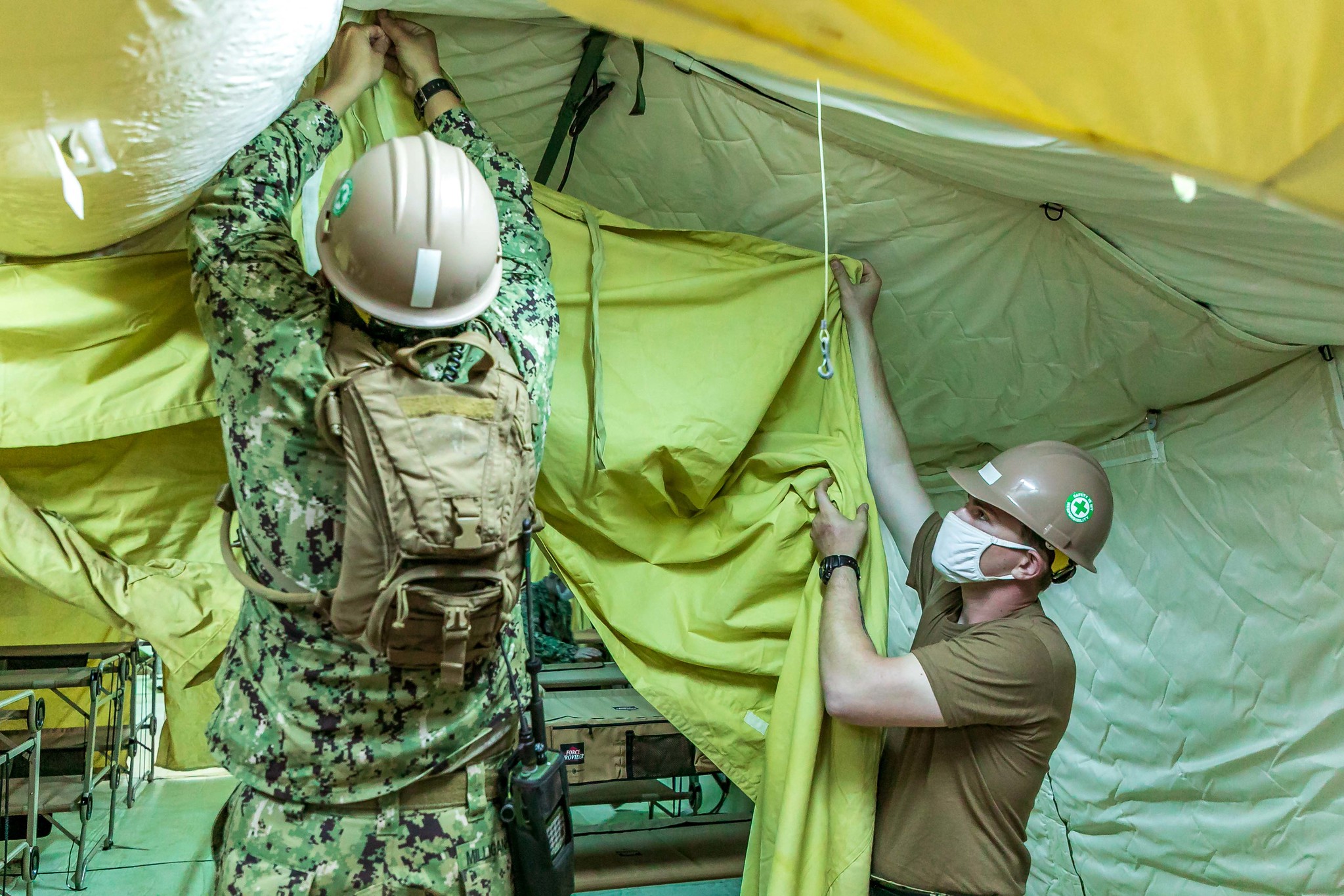
U.S. service members install a room divider in a berthing tent for a Covid-19 medical facility in Dededo, Guam. (U.S. Navy, Matthew R. White)
A world of recurring pandemics will make it nearly impossible for U.S. forces to work side-by-side with their foreign counterparts, especially in poorer nations that lack adequate health and sanitation facilities. This is already true in Iraq and Afghanistan, where the coronavirus is thought to have spread widely among friendly local forces and American soldiers have been ordered to suspend joint training missions with them.
A return to the pre-Covid world appears increasingly unlikely, so the search is now on big time for a new guiding strategy for Army and Marine combat operations in the years to come. As with the Navy, this search actually began before the outbreak of the coronavirus, but has gained fresh urgency in its wake.
To insulate ground operations from the dangers of a pandemic-stricken planet, the two services are exploring a similar operating model: instead of deploying large, heavily-armed troop contingents close to enemy borders, they hope to station small, highly mobile forces on U.S.-controlled islands or at other reasonably remote locations, where they can fire long-range ballistic missiles at vital enemy assets with relative impunity.
To further reduce the risk of illness or casualties, such forces will, over time, be augmented on the front lines by ever more “unmanned” creations, including armed machines — again those “killer robots” — designed to perform the duties of ordinary soldiers.

A naval research autonomous firefighting robot undergoes testing aboard the ex-USS Shadwell in Mobile, Alabama, Nov. 6, 2014. (U.S. Navy, John F. Williams)
The Marine Corps’ version of this future combat model was first spelled out in Force Design 2030, a document released by Corps commandant General David Berger in the pandemic month of March 2020. Asserting that the Marines’ existing structure was unsuited to the world of tomorrow, he called for a radical restructuring of the force to eliminate heavy, human-operated weapons like tanks and instead increase mobility and long-range firepower with a variety of missiles and what he assumes will be a proliferation of unmanned systems.
“Operating under the assumption that we will not receive additional resources,” he wrote, “we must divest certain existing capabilities and capacities to free resources for essential new capabilities.” Among those “new capabilities” that he considers crucial: additional unmanned aerial systems, or drones, that “can operate from ship, from shore, and [be] able to employ both [intelligence-]collection and lethal payloads.”
In its own long-range planning, the Army is placing an even greater reliance on creating a force of robots, or at least “optionally manned” systems. Anticipating a future of heavily-armed adversaries engaging U.S. forces in high-intensity warfare, it’s seeking to reduce troop exposure to enemy fire by designing all future combat-assault systems, including tanks, troop-carriers, and helicopters, to be either human-occupied or robotically self-directed as circumstances dictate.
The Army’s next-generation infantry assault weapon, for instance, has been dubbed an optionally manned fighting vehicle(OMFV). As its name suggests, it is intended to operate with or without onboard human operators. The Army is also procuring a robotic utility vehicle, the squad multipurpose equipment transport (SMET), intended to carry 1,000 pounds of supplies and ammunition. Looking further into the future, that service has also begun development of a robotic combat vehicle (RCV), or a self-driving tank.
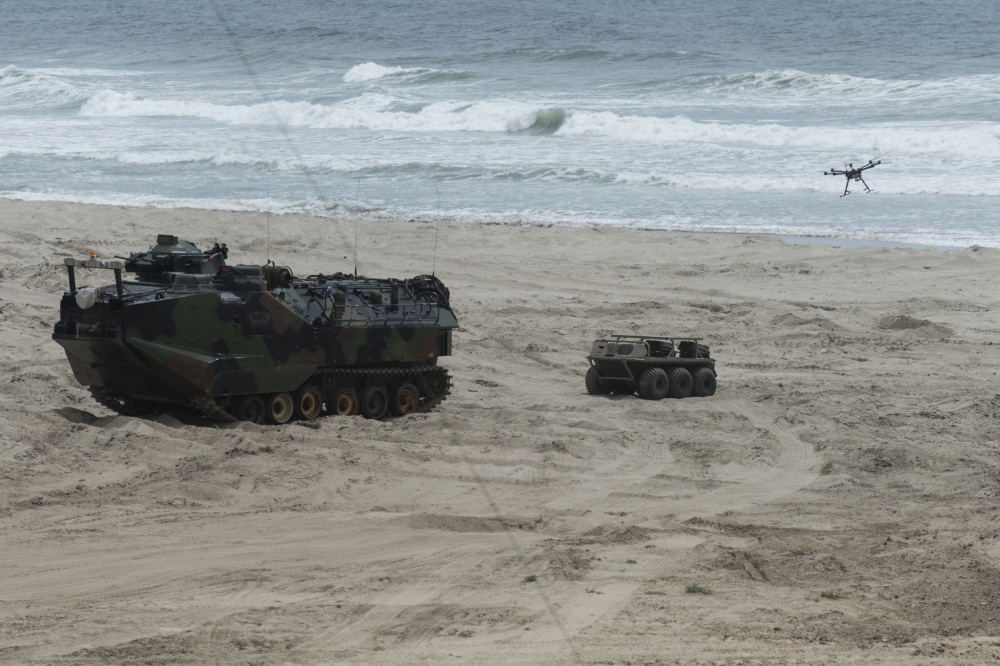
Unmanned aerial vehicle launches from a multi-utility tactical transport (MUTT) vehicle after exiting an Autonomous AAV during an advanced naval technology exercise, Camp Pendleton, California, April 2017. (U.S. Navy, John F. Williams)
The Army is also speeding the development of long-range artillery and missile systems that will make attacks on enemy positions from well behind the front lines ever more central to any future battle with a major enemy. These include the extended range cannon artillery, an upgraded Paladin-armored howitzer with an extra-long barrel and supercharged propellant that should be able to hit targets 40 miles away, and the even more advanced precision strike missile (PrSM), a surface-to-surface ballistic missile with a range of at least 310 miles.
Many analysts, in fact, believe that the PrSM will be able to strike at far greater distances than that, putting critical enemy targets — air bases, radar sites, command centers — at risk from launch sites far to the rear of American forces. In case of war with China, this could mean firing missiles from friendly partner-nations like Japan or U.S.-controlled Pacific islands like Guam. Indeed, this possibility has alarmed Air Force supporters who fear that the Army is usurping the sorts of long-range strike missions traditionally assigned to combat aircraft.
A Genuine Strategic Redesign
All these plans and programs are being promoted to enable the U.S. military to continue performing its traditional missions of power projection and warfighting in a radically altered world. Seen from that perspective, measures like removing sailors from crowded warships, downsizing U.S. garrisons in distant lands, and replacing human combatants with robotic ones might seem sensible. But looked at from what might be called the vantage point of comprehensive security — or the advancement of all aspects of American safety and wellbeing — they appear staggeringly myopic.
If the scientists are right and the coronavirus will linger for a long period and, in the decades to come, be followed by other pandemics of equal or greater magnitude, the true future threats to American security could be microbiological (and economic), not military. After all, the current pandemic has already killed more Americans than died in the Korean and Vietnam wars combined, while triggering the worst economic downturn since the Great Depression.
Imagine, then, what a more lethal pandemic might do. The country’s armed forces may still have an important role to play in such an environment — providing, for example, emergency medical assistance and protecting vital infrastructure — but fighting never-ending wars in distant lands and projecting power globally should not rank high when it comes to where taxpayer dollars go for “security” in such challenging times.
One thing is inescapable: as the disaster aboard the Theodore Roosevelt indicates, the U.S. military must reconsider how it arms and structures its forces and give serious thought to alternative models of organization. But focusing enormous resources on the replacement of pre-Covid ships and tanks with post-Covid killer robots for endless rounds of foreign wars is hardly in America’s ultimate security interest. There is, sadly, something highly robotic about such military thinking when it comes to this changing world of ours.
Michael T. Klare, a TomDispatch regular, is the five-college professor emeritus of peace and world security studies at Hampshire College and a senior visiting fellow at the Arms Control Association. He is the author of 15 books, including the just-published, “All Hell Breaking Loose: The Pentagon’s Perspective on Climate Change” (Metropolitan Books), on which this article is based.
This article is from TomDispatch.com.
The views expressed are solely those of the author and may or may not reflect those of Consortium News.
Please Contribute to Consortium
News on its 25th Anniversary
Donate securely with  PayPal here.
PayPal here.
Or securely by credit card or check by clicking the red button:

We need to dismantle this militaristic mindset and really start to contemplate what it is doing not only to people but to the planet!
I am sincerely tired of a large portion of my taxes being used by the military to create toys for them to dream up and play with. Our military is given obscene amounts of money to keep us “safe”. We would be much better off if we were communicating with our “enemies “. The current military scheme sounds like some conspiracy theory by Trump’s favorite and medaled “intellectually important” conspiracy theorist from Texas.
There never seems to be even the slightest acknowledgement that peace might be a possible goal and worth at least trying to achieve. The USA assumes that violence is the only way, that any non-compliant nation is an enemy and needs to be attacked, threatened, sanctioned, vilified….. International law is regarded as “not for us”- we are far too important, rich and led by corporation- linked military strategists with no thought of negotiations, agreements, treaties which might actually avoid the conflicts we relish.
It’s good that the navy is planning for unmanned ships by 2030 because, the way we’re going, humans are likely to be swiftly headed for extinction by then.
All this and the USA still cannot seem to win a War (since WWII). Of course, every time we lose a War, the military just asks (and gets) more money to do War better the next time. What a farce. Wake up America.
Please do NOT keep up the pretence that the USA won WW2, which was decisively won by the USSR with huge losses and the Western Front was far behind and much less important. At the time even the USA admitted this, but conveniently introduced the cold War and Russian wickedness to make Russia the enemy even now.
Of course the Soviets were most responsible for the victory, but the US was on the winning side and made a significant contribution in blood and treasure.
I suppose if it had been a robocop, as it were, that had been dispatched to investigate George Floyd’s suspicious $20 bill, he would still be alive, along with the thousands who will die from the Covid effects of the mass protests. The corruptibility and fallibility of humans seems to almost beg to be replaced by the machines, who can say which will be more dystopian, more Derek Chauvins or the machines? It seems we already have the worst of both worlds with the human controlled drone killings.
The only “Genuine Strategic Redesign” that is needed is for Congress to redesign the military
budget to be 50% or so smaller.
Always war. Always on the offensive. Never a thought to diplomacy and peace, which doesn’t cost a dime and saves lives and the health of our planet. At some point in time the rest of the world, that has not gone insane, is going to say enough is enough one way or another. At this time, it seems to center on financial warfare, as China, Russia and other countries (even allies like Germany) figure out ways to circumvent our punitive dollar system to acquire oil and other commodities by dealing among themselves. That, I’m sure, will send those American drones and other automated warfare into overdrive.
Ah, but, Punkyboy, the Lives of those “others” do not matter one iota. They are as the lives of fleas from this country’s ruling elites (financial, political, military and so-called intelligence). Only their (ruling elites) lives matter, are worthy of concern. Money is to be made endangering, destroying the lives of those “others” – the more so if they are not as low melanin as “we” are.
Russia is already claiming it has developed nuclear capable naval drones that can even quietly push up rivers like the Mississippi. The US is not likely to find itself alone in developing naval drones.
One can only hope so. Otherwise we are doomed….
And why is it that we assume that Russia and China are not already ahead of us in these spheres????
Terminator: The Prequel
Sadly, Mr. Klare lacks the wit to assess the difference between offensive operations and defensive operations. For all it being called the department of defense instead of the department of war, the US military is an offensive command focused on attacking other countries, not focused on defending the US. One does not need robotic dreadnoughts to defend the US and other countries can certainly counter our dreadnoughts by simply hiding from them until they are attacked. The US will certainly not be menacing other countries from bases around the world. (Even if we had the money for it.)
Well this sucks. A future where the US terrorizes the planet with destroyer-sized drones, encircling countries like China with enough fire power to kill thousands or millions, and not suffer a single casualty from the safety of an air conditioned lounge in Nevada. It will be like Afghanistan, but on the scale of world war. What of the scenario where the only way adversary countries can meaningfully strike back against the US, is an ICBM?
What did we expect to come from 30yr of internet war games. Just the logic behind this type of thinking is childish.